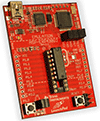Optimizing Optoisolators, and Other Stories of Making Do With Less
It’s been a few months since I’ve rolled up my sleeves here and dug into some good old circuit design issues. I started out with circuit design articles, and I’ve missed it.
Today’s topic will be showing you some tricks for how to get more performance out of an optoisolator. These devices — and I’m tempted to be lazy and call them “optos”, but that sounds more like a cereal with Greek yogurt-covered raisins — are essentially just an LED...
[ C Programming Techniques: integer type optimization ]
I am currently working on a voltage controller running on a ATMEGA328P, ATMEL AVR 8 bits microcontroller. The controller logic is implemented in the main() routine and relies on a periodical timer whose frequency is fixed at application setup. Among other things, the timer ISR handler increments some per tick counters which are then used by the main routine to implement the voltage controller timing logic.By looking at the code, one noticed that I use the uint8_t type for counters instead of...
[ C Programming Techniques: integer type optimization ]
I am currently working on a voltage controller running on a ATMEGA328P, ATMEL AVR 8 bits microcontroller. The controller logic is implemented in the main() routine and relies on a periodical timer whose frequency is fixed at application setup. Among other things, the timer ISR handler increments some per tick counters which are then used by the main routine to implement the voltage controller timing logic.By looking at the code, one noticed that I use the uint8_t type for counters instead of...
Embedded Firmware Refactoring, Optimisation and Migration
Legacy products are often based on older hardware platforms which often become under-powered or run out of memory which constrains further product development. Customers are always looking for new features and improved performance but often either don’t want to invest in new hardware or need to retain the current field population of devices.
These are ongoing challenges for any product manufacturer, but are particularly highlighted in embedded systems where product...
Assembly language is best - except when it isn’t
A look at why writing in C often produces more efficient code than hand-written assembly language.
Flood Fill, or: The Joy of Resource Constraints
When transferred from the PC world to a microcontroller, a famous, tried-and-true graphics algorithm is no longer viable. The challenge of creating an alternative under severe resource constraints is an intriguing puzzle, the kind that keeps embedded development fun and interesting.























